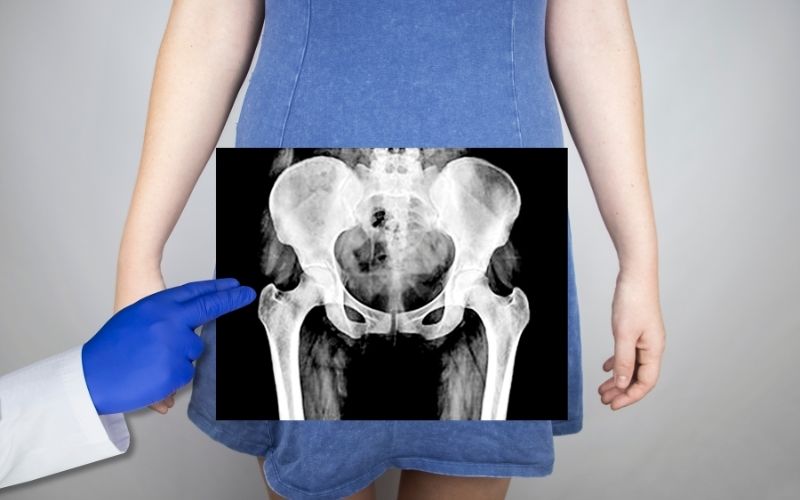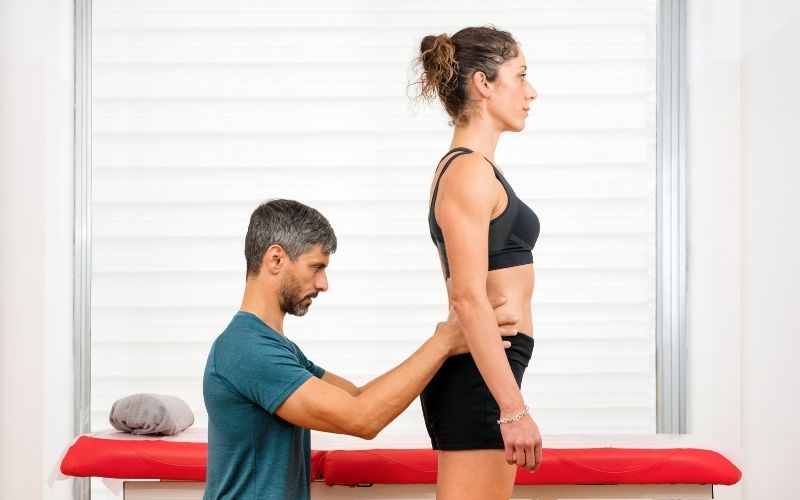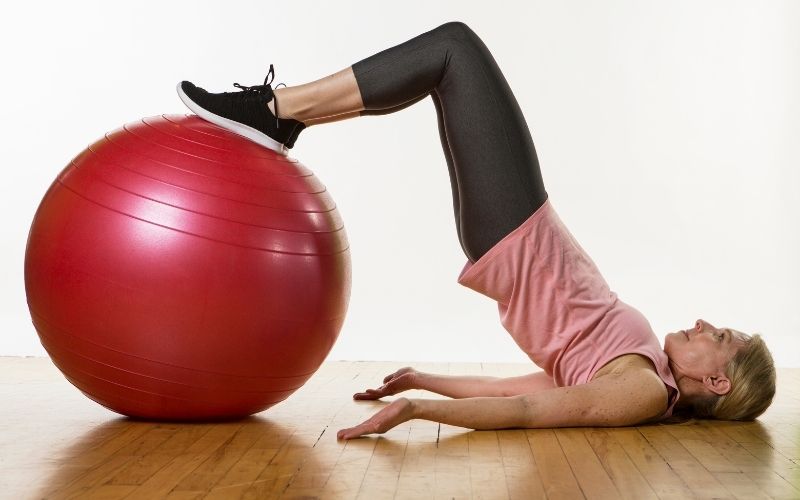Pelvic pain, whether sudden and temporary or chronic, is experienced by a lot of women. Although some men may also experience pelvic pain, it is a more common occurrence in women and even more common in pregnant women.
As the intensity of pelvic pain can fluctuate, determining its exact cause becomes a difficult task. For example, UTIs and STDs may cause discomfort in the pelvic area but pelvic pain can also be caused by uncomfortable postures or other more severe health issues.
One of the best ways to alleviate pelvic pain is using an exercise ball to stretch the area. An exercise ball or pregnancy ball can be used in various ways to stretch this part of the body and help ease the pain. It can also help strengthen the pelvic muscles and improve overall posture and balance, especially in pregnant women.
This article answers all your queries regarding pelvic pain and provides you with five effective exercises to help alleviate it.
Table of Contents
What is Pelvic Pain?
Any pain below the belly button and above the legs is considered pelvic pain. It can either be acute, which is sudden and severe, or chronic, which is persistent pain that can last months.

There are several reasons, both physiological and psychological, that can cause pelvic pain. But since some forms of pelvic pain can radiate up to the abdomen, it is not always easy to determine whether it is pelvic pain or abdominal pain.
Here are some of the most common causes of pelvic pain:
- Pelvic inflammatory disease (PID)
- Uterine fibroids
- Endometriosis
- Ovarian cyst
- Musculoskeletal problems
- Irritable bowel syndrome
- Appendicitis
- Pelvic congestion syndrome
- Painful bladder syndrome (interstitial cystitis)
- Sexually transmitted diseases
- Pelvic inflammatory disease
Apart from these, there are also other causes like gynecologic cancers, pelvic pain during pregnancy, and even emotional distress.
What is Pelvic Girdle Pain?
The pelvic girdle is a group of bones located at the base of the spine that connects the torso and legs. It is also sometimes called the bony pelvis.

The pelvic girdle has a lot of functions, including balancing the trunk and supporting the intestines, the internal sex organs, and the urinary bladder.
Pelvic girdle pain is most commonly experienced by pregnant and postpartum women. It is a pain felt either in front or at the back of the pelvis such as in the hips or thighs.
The experience of pelvic girdle pain may differ for everyone. Some may feel a slight discomfort, while others may find the pain disabling, and can make them unable to carry out simple daily tasks.
Causes of Pelvic Girdle Pain

Pelvic girdle pain can occur for various reasons, typically because the pelvis joints move unevenly.
For pregnant women, the pain is usually gradual as the baby grows. The extra weight plus the changes in the woman’s posture as their pregnancy progresses, puts strain on their pelvis.
For people suffering from pelvic girdle pain who are not pregnant, back problems or any injury in that area would cause pelvic pain.
Pelvic girdle pain can also occur in persons with hypermobility syndrome, which causes their joints to stretch more than that of an average person.
How Can You Treat Pelvic Girdle Pain?
There are various treatment options for pelvic girdle pain.
You can take simple measures to manage your symptoms, like not sitting in one position for a long time, avoiding heavy lifting, or even putting a pillow in between your legs when you are sleeping to help with the pain.

- A physiotherapist would usually advise you to avoid specific movements that can worsen the pain, and they will advise on the best positions for you to move and rest.
- Manual therapy like massage and other osteopathic and chiropractic procedures can also help.
- Warm baths and ice packs are recommended.
- Hydrotherapy.
- Acupuncture.
- Stretching and targeted exercises for the pelvic girdle.
Can an Exercise Ball Help With Pelvic Pain?
An effective way to relieve pelvic pain is stretching or exercising by using an exercise ball.
Not only will it reduce the pain, but it will also strengthen the muscles in the abdominal area and the pelvic floor. Using an exercise ball will improve balance and posture, which could exacerbate the pain.
Exercise balls, also known as Swiss balls, physioballs, or fit balls, are made of vinyl and are used for a wide range of exercises from strength training to stretching. It can help improve your core stability and stretch your muscles.
5 Exercise With an Exercise Ball for Pelvic Pain
1. Bridge on a Ball
This exercise helps improve pelvic stability and engages abdominal muscles. This video by Pain Therapy presents the exercise clearly, and although the tutorial is not for pregnant women, the form and technique are the same.
- Lay down on the floor and place both your feet and calf on top of the exercise ball. Keep your knees straight and hands flat on your sides to help stabilize your body.
- Breathe in, and when you breathe out, raise your buttock about 30 centimeters off the floor. Make sure that your pelvic floor muscles or glutes are engaged.
- Slowly lower your lower body back to the floor as you breathe out.
- Repeat this exercise a few times with control before resting your buttocks again on the floor without arching your back.
2. Ischial Exercise on Swiss Ball
This gentle hip stretch can help ease pelvic pain and take the pressure off the lower back, especially if you have pelvic pain because of posture problems from sitting for prolonged periods.
- Ensure that feet and calf are resting on the ball and your hands are straight on your sides.
- When you breathe out, lift your buttocks 30 centimeters above the air with your pelvic floor muscles engaged the whole time. Breathe in and hold this position.
- As you breathe out, bend your knees with your feet flat on the ball as you move the ball under your buttocks. Breathe in while holding this position, and then breathe out as you stretch your legs.
- Repeat this process five times before carefully lowering your buttocks on the ground.
3. Sitting and Raising Feet on Exercise Ball
This exercise is a simple way to relieve the pain, especially if you feel pain in your upper thighs. BodyFit Physiotherapy Group has a video of how to do this simple exercise.
- Sit on the ball by keeping your back straight and your feet firm on the floor.
- Every time you inhale, engage your core to keep yourself stable as you lift a leg and hold the position for ten seconds. Repeat using the other leg.
- Do this exercise five times using each leg, and remember to keep your belly and pelvis engaged.
4. Knee Tuck and Pike
This exercise will benefit both your abdominal and your pelvic floor muscles. If you are pregnant, ask your partner or a friend to help you with this one.
- Get on your hands and knees with the exercise ball behind you, and then place your feet on the ball one at a time. Your feet should rest on the ball while your body is in a plank position.
- Breathe in and bend your knees to push the exercise ball towards you and breathe out as you stretch back into the first position.
- Breathe in again, and on the exhale, hoist your hips up to the ceiling, and this will make your wrists, shoulders, and your hips aligned (pike position). Inhale and return to the first plank position.
- Do five to ten repetitions.
5. Lower and Lift with Plow
This exercise is beneficial not only for your pelvic floor but also for your spinal flexors. Be careful in doing this exercise, and don’t put too much strain on your back.
- Lay on your back with the exercise ball between your ankles as you lift your legs to the ceiling.
- As you exhale, lower your legs without your back arching.
- Inhale as you lift your legs back to the first position and then move your legs towards your face to try to make the exercise ball touch the floor above your head.
- Slowly roll your legs back down, keeping your spine straight. Do at least ten reps.
- If your spine is not flexible, you can do this exercise until step two and then count the second rep as you go back to the first position.
For pregnant women who are experiencing pelvic girdle pain, all of these exercises may not be feasible. However, there are other stretches and exercises that can greatly alleviate the pain. Here are two sets of exercises worth trying to ease pelvic girdle pain.
Conclusion
An exercise ball is a versatile exercise tool that can also double as an effective rehabilitating apparatus to alleviate pelvic pain. Remember not to push yourself too much and always engage your core and pelvic muscles to get the most relief from these exercises.
If you find the pain persisting despite home remedies and exercises, please consult your doctor immediately.

My name is Vance, and I am the owner of To Ergonomics. Our mission is to improve your workflow by helping you create a supportive and welcoming environment. We hope that you’ll find what you’re looking for while you’re here.

